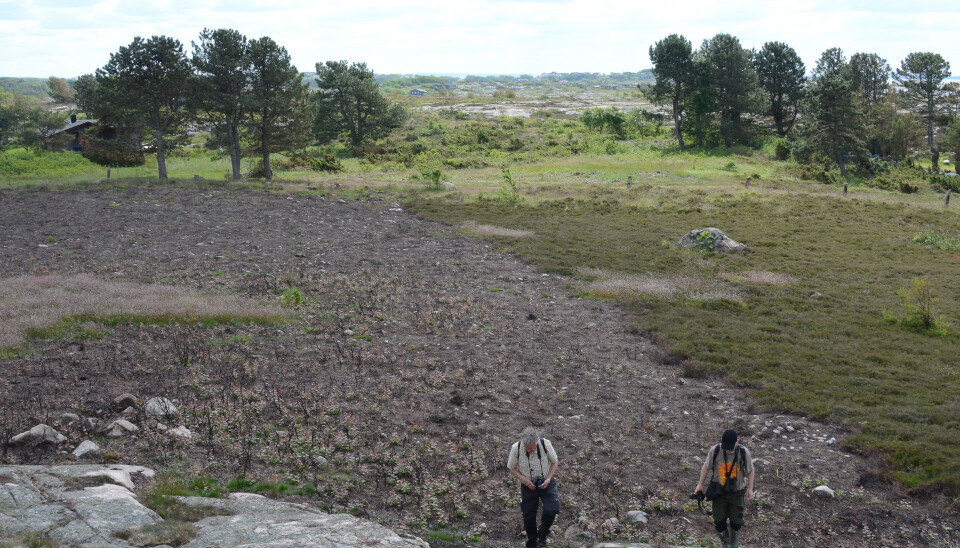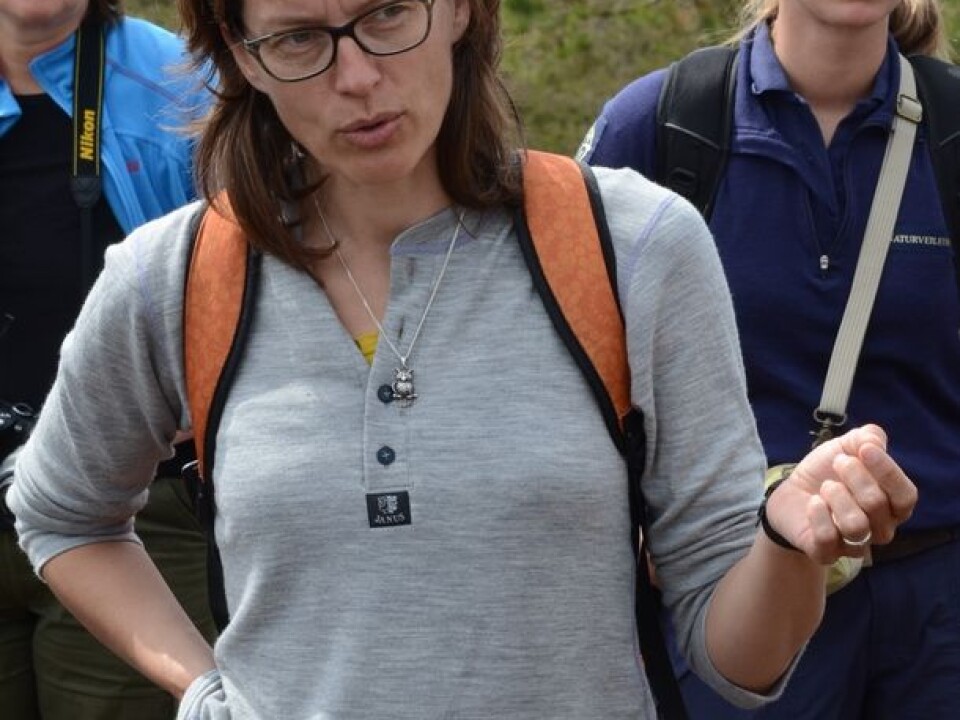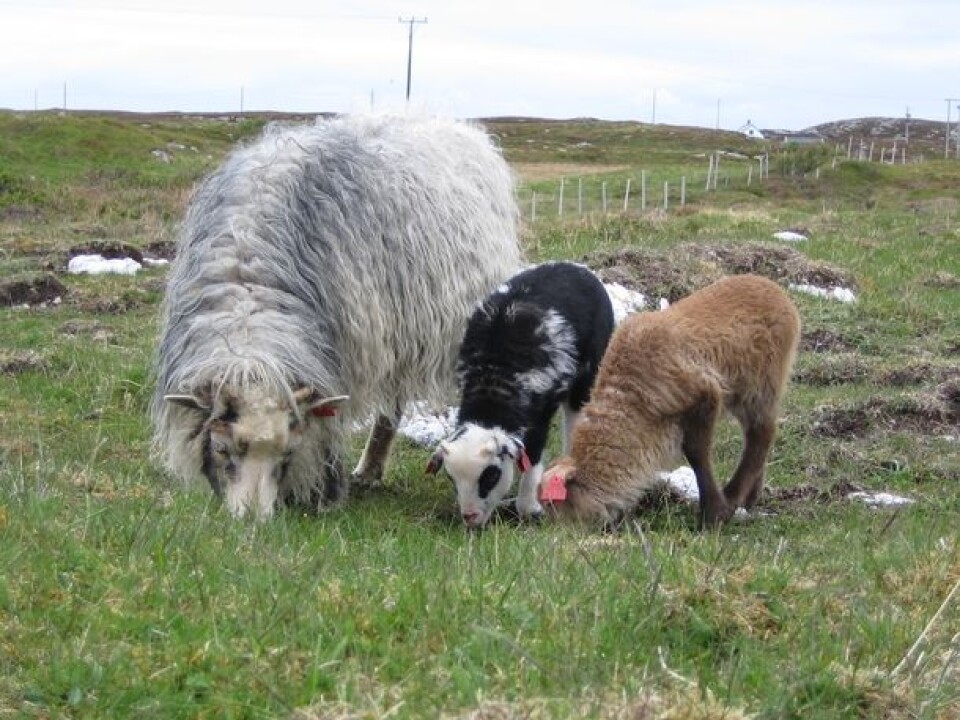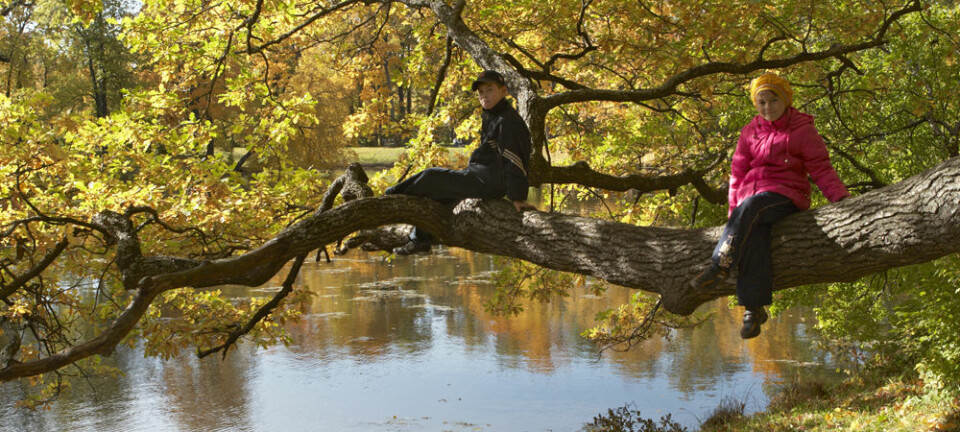This article was produced and financed by Norwegian Institute for Agricultural and Environmental Research

The Viking landscape – an endangered habitat
The oldest cultural landscape in Norway consists of coastal heathlands that have been continuously managed by humans since before the Bronze Age. This is the landscape the Vikings saw when they sailed up and down the Norwegian coast.
Denne artikkelen er over ti år gammel og kan inneholde utdatert informasjon.
Coastal heathlands are tree-less habitats dominated by heather (Calluna vulgaris) and other dwarf shrubs. The landscape was created by forest clearance, and has been maintained through continuous grazing by sheep, cows and goats in combination with heather burning, heather removal and clearance of shrubs and woodland.
The coastal heathlands in Norway are part of the European coastal heathlands which extend along the Atlantic coast from Portugal to Lofoten in Northern Norway.
Pollen studies revealed the history of coastal heathlands
"For a long time it was thought that the coastal heathlands had emerged as a result of a dramatic climatic cooling, the so-called Fimbul winter, which caused the forest to disappear along the Norwegian coast," says Professor Peter Emil Kaland from the University of Bergen, Norway.
He set out to prove that this was not the case.

"In the early 1970's we went from farm to farm to study pollen layers in bogs. By using radiocarbon dating we were able to accurately date the transition from woodland to heathland," he says.
They could then determine at what point of time the forest had receded from each farm. This did not happen simultaneously – in fact it took 3000 years for the forests along the Norwegian coast to disappear.
Studies of ash, however, reveal that forest clearance and heathland establishment was always linked to recurrent fires – proving that there has been a tradition for continuous burning of the heathlands along the coast.
Heather vital for winter grazing
"The combination of animal husbandry and fishing has been important for the livelihoods of people along the Norwegian coast," says Liv Guri Velle, researcher at Norwegian Institute for Agricultural and Environmental Research (Bioforsk).

In order to keep animals outside the entire year, access to winter fodder is important. This is where heather comes into the equation. Heather is a wintergreen plant and constitutes an important grazing resource during winter, when grass and herbs are withered.
Heather is a very common plant on the coastal heathlands. When the heather grows old and coarse, the heathland is burned to improve grazing conditions for livestock. This enables grass, herbs and young heather plants to flourish, before the heather again overgrows and dominates the landscape.
When the time comes to improve grazing conditions, the moorland is burned again.
"It is the continuous use which renders the coastal heathland open and treeless," says Velle.

"If you remove the animals and stop burning, the heather will give way to shrubs, bushes, and finally forest. This can be observed many places along the Norwegian coast."
Lack of maintenance allows the landscape to overgrow
The first coastal heaths along the Norwegian coast were created approximately 5000 years ago. During the Bronze Age, the landscapes experienced a vast expansion, and heather began to dominate the landscape.
This land-use regime continued more or less unchanged up until the Second World War, when the heathland burning that was discontinued and the landscape was left to overgrowth.
"Due to the discontinuation of the traditional land-use, coastal heath is now an endangered habitat," explains Professor Vigdis Vandvik from the University of Bergen.
"The only way we can take care of the Norwegian coastal heathland, is to re-establish the traditional land-use, grazing and burning, of these areas. Societal trends such as «slow food» and «organic food» can contribute to make this viable for modern farmers. We hope that more people will take interest in resuming the use of our coastal heathlands."
The Norwegian authorities are now making plans for how to best preserve the coastal heathlands, and for which areas to prioritize.
The coastal heathland network: LyngNett
The Norwegian coastal heathland network – LyngNett – was established in 2005, Vandvik says. The network is comprised of approximately 40 members who meet every second year to study and discuss coastal heathlands in Norway.
This summer the network met up at Ytre Hvaler National Park.
The main objective of the coastal heathland network is to highlight and promote the research, conservation efforts, and management going on in Norwegian coastal heathlands, and also to initiate cooperation between groups that focus on different issues concerning the heaths. LyngNett also wishes to increase the understanding for, and knowledge about, the value and status of coastal heathlands as a cultural landscape.
The network aims to contribute to a sustainable management that will preserve the heathlands.
- As a researcher, it is extremely valuable to meet «the others», Vandvik says. It is interesting to see how the new biodiversity law works, and to develop collaboration with heathland farmers, municipalities, and conservation authorities.
Increased interest in Old Norse Sheep
"Old Norse Sheep is an ancient and special sheep breed. It is smaller in size than modern sheep breeds," says Vandvik.
Moreover, the fat is marmored into the meat in a different way than in other breeds. There is reason to believe that this type of sheep isn't as prone to predators as the modern breeds. The interest for Old Norse Sheep has increased dramatically the last years, and they have estimated that there are about 60,000 Old Norse Sheep grazing in Norway.
One of the participants at the network meeting at Hvaler, was Leif Christian Torsøe, CEO of Agder Villsau (Norwegian for wild sheep). He had a genuine interest in traditional livestock races and started working with wild sheep in 1993.
The first sheep he owned grazed on pastures at his farm in Vennesla. In 1996 he rented a peninsula in Lindesnes County which could be used as a grazing area for his sheep.
"Since then we've expanded our operation, and now we make use of a large area consisting of several islands and peninsulas," says Torsøe.
"5,000 acres heathland is at our disposal in Lindesnes. 50 wild sheep graze there. We also contribute to the restoration of the area by burning the moor and clearing the area of Sitka spruce."
Several sheep owners have joined forces and established a coastal grazing network called Agder kystbeitelag. Their goal is to work towards better prices at the slaughterhouses. The meat is sold as short food in southern Norway.
"We use sheep dogs to collect the wild sheep," says Torsøe. "It works out nicely, and the animals are herded together like a flock of musk oxen."
Natural versus cultural conservation
"We are used to setting natural and cultural conservation up against each other," says Vigdis Vandvik.
"Traditionally, it has been easier to argue for natural conservation rather than cultural landscape. One can, however, ask the question – what is nature? In countries such as Denmark, the Netherlands and Belgium, coastal heathlands are seen as an important part of the natural landscape."
"We see the coastal heathlands as a semi-natural type of nature created through interaction with people, or a habitat influenced by humans."
Translated by: Kathrine Torday Gulden
































